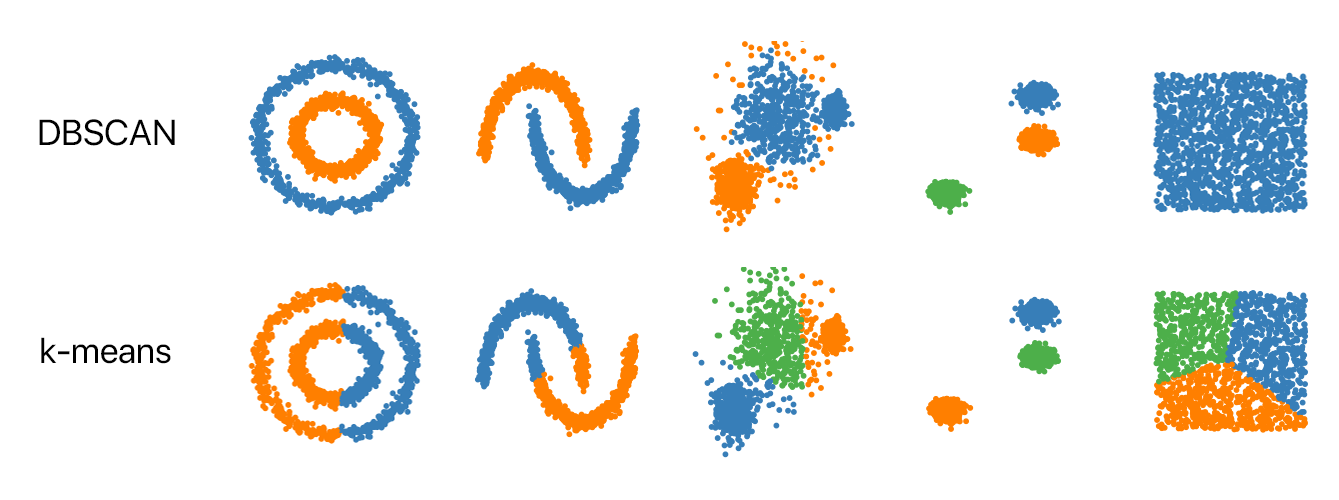emilklindt / laravel-marker-clusterer
在 Laravel 中使用服务器端聚类显示大量标记
Requires
- php: ^7.4|^8.0
- illuminate/support: >=5.1
- league/geotools: ^0.8.3
- spatie/data-transfer-object: 2.8.3
Requires (Dev)
- fakerphp/faker: ^1.15
- mockery/mockery: ^1.4
- orchestra/testbench: ^5.0|^6.0
- phpunit/phpunit: ^9.3
README
emilklindt/laravel-marker-clusterer 包允许您在发送到客户端之前在 Laravel 中对标记进行聚类。
在处理大量数据集时,可能无法或实际发送所有数据点到客户端。这可能是由于传输所有数据点所需的较大有效负载,或者为了避免在客户端上过度处理。本项目旨在通过 Laravel 的服务器端标记聚类来促进这些情况。
安装
您可以通过 composer 安装此软件包
composer require emilklindt/laravel-marker-clusterer
该软件包将自动注册自己。
发布配置文件
您可以选择使用以下命令发布配置文件:
php artisan vendor:publish --provider="EmilKlindt\MarkerClusterer\MarkerClustererServiceProvider" --tag="config"
这是将发布到 config/marker-clusterer.php 的文件内容
配置文件内容
return [ /* |-------------------------------------------------------------------------- | Default Clusterer |-------------------------------------------------------------------------- | | The default clustering method used when using the DefaultClusterer class | included in this project. This allows for easily swapping of the clusterer | used throughout a project, through only editing the config file. | */ 'default_clusterer' => 'density-based-spatial-clusterer', /* |-------------------------------------------------------------------------- | Default Distance Formula |-------------------------------------------------------------------------- | | The default formula for calculating distance from one coordinate to | another. Possible values are constants of the DistanceFormula enum. | */ 'default_distance_formula' => \EmilKlindt\MarkerClusterer\Enums\DistanceFormula::MANHATTAN, /* |-------------------------------------------------------------------------- | K-means Clustering |-------------------------------------------------------------------------- | | K-means algorithm identifies k number of centroids, and then allocates | every data point to the nearest cluster. | */ 'k_means' => [ /* |-------------------------------------------------------------------------- | Default Maximum Iterations |-------------------------------------------------------------------------- | | The default number of maximum iterations of clustering, for example used | in K-means clustering, where clustering is repeated untill either reaching | convergence (no further changes) or the maximum number of iterations. | */ 'default_maximum_iterations' => 10, /* |-------------------------------------------------------------------------- | Default Maximum Convergence Distance |-------------------------------------------------------------------------- | | The maximum distance between iterations to count a cluster as converged, | meaning that no further iteration is necessary. A higher value can provide | better performance, due to the need of doing less iterations. A lower value | will ensure that a cluster has actually converged. | */ 'default_convergence_maximum' => 100.0, /* |-------------------------------------------------------------------------- | Default Maximum Samples |-------------------------------------------------------------------------- | | The default number of maximum samples of clustering, for example used | in K-means clustering, where the specified number of samples are run | to achieve the lowest variance between the centroids. | | This differs from maximum iterations in that, iterations are executed | on the same set of initially random centroids. Each sample instantiates | a new set of centroids to iteratively optimize, untill maximum number | of iterations or convergence is reached. | */ 'default_maximum_samples' => 10, ], /* |-------------------------------------------------------------------------- | Density Based Spatial Clusterer (DBSCAN) |-------------------------------------------------------------------------- | | Finds core samples of high density and expands clusters from them. | */ 'dbscan' => [ /* |-------------------------------------------------------------------------- | Default Include Noise |-------------------------------------------------------------------------- | | Whether to include markers not meeting the threshold of minSamples. | If true, markers not within epsilon distance of at least minSamples, | will be included anyways, in a solo cluster for that given point. */ 'default_include_noise' => true, /* |-------------------------------------------------------------------------- | Default Use Geohash Neighboring |-------------------------------------------------------------------------- | | When response time is critical and precision is not, it may sometimes | be beneficial to use geohashing for neighbor searching only. A geohash | is calculated for every marker when added to the clusterer. This is | used to limit the scope of distance calculations to only points that | fall within neighboring geohashes. | | Enabling this setting will remove the last step, which is calculating | exact distance to each marker in the neighboring geohashes, and then | comparing it against the epsilon value. | | The geohash precision is based on the epsilon value, so by specifycing | a larger epsilon value, more markers will be considered neighbors etc. */ 'default_use_geohash_neighboring' => false, ] ];
用法
为了在整个应用程序中管理使用的聚类算法,建议您使用 DefaultClusterer 类。它使用 marker-clusterer 配置中的 default_clusterer 值,可以通过 发布配置 简单地更改。
$clusters = DefaultClusterer::cluster($markers, $config);
添加您的标记
聚类器接受标记集合。然而,这些标记必须实现 Clusterable 接口,该接口有一个用于检索标记坐标的单个方法。
在您的 Eloquent 模型中的示例实现可能如下所示
use League\Geotools\Coordinate\Coordinate; use EmilKlindt\MarkerClusterer\Interfaces\Clusterable; class Car extends Model implements Clusterable { public function getClusterableCoordinate(): Coordinate { return new Coordinate([ $this->lat, $this->lng ]); } }
聚类您的标记
实现接口后,一组汽车可以按如下方式聚类
$cars = Car::get(); $config = new Config([ 'epsilon' => 10.5, 'minSamples' => 2 ]); $clusters = DefaultClusterer::cluster($cars, $config);
请参阅下面的 聚类 部分,了解不同的聚类方法和它们的参数。
聚类器
欢迎贡献或功能请求。请随意创建拉取请求或在其 想法 讨论主题中发布您的功能请求。
 来源:NSHipster/DBSCAN 存储库
来源:NSHipster/DBSCAN 存储库
K-means 聚类
可能是最著名的聚类算法,k-means 聚类 将 n 个元素划分为 k 个聚类。
如上图所示,K-means 将标记聚类到最近的均值所在的聚类中,即标记到聚类中心的最近距离。K-means 需要一个 k 值,即所需的聚类数量。根据您的数据集,有 许多不同的方法 来选择此值,但这个方法尚未在本存储库中介绍。
$config = new Config([ 'k' => 3 ]); $clusters = KMeansClusterer::cluster($cars, $config);
适用于 KMeansClusterer 的配置参数
-
k,整数(必需)
所需的聚类数量以及要随机初始化的初始 质心(聚类点)数量。如果 k 大于标记数量,所有标记将单独聚类。 -
iterations,整数(可选)
重新计算质心(聚类点平均位置)并分配标记到最近聚类的最大迭代次数。在随机初始化聚类后,标记被分配到最近的聚类,然后重新计算聚类质心,重复此过程。 -
convergenceMaximum,float(可选)
两次连续迭代中聚类质心之间的最大距离,以此宣布收敛,它与iterations一起是生成聚类样本的停止标准。在更改distanceFormula时,可能需要调整此值,因为每个距离公式具有不同的准确度。 -
samples,int(可选)
初始化聚类随机质心的次数以及执行iterations次数的优化迭代。找到samples数量的聚类样本后,选择方差最低的聚类样本(示例,由Arif R,Medium提供)。更高的值更有可能得到最佳结果,但会以性能为代价。 -
distanceFormula,string(可选)
用于计算点之间距离的公式。距离用于确定标记最近的聚类。有效值是DistanceFormula枚举的常量。如果聚类任务对精度很重要,则首选Haversine距离。
所有标记为可选的属性都具有默认值,在配置中指定。请参阅上面的发布配置文件部分以操作这些。
基于密度的空间聚类
使用的算法是基于密度的空间聚类应用噪声(DBSCAN)。
这种方法克服了K-means聚类的一个常见问题,即需要指定聚类的数量。此参数可能依赖于数据集——更具体地说,是数据集的密度。DBSCAN算法采用epsilon(两个点被分组在一起的最大距离)和minSamples(要分组形成聚类的最小点数)。
“应用噪声”部分意味着,该聚类方法能够处理噪声。这意味着不直接与聚类相关的点,可能根据includeNoise配置被丢弃或作为单独的点返回。
$config = new Config([ 'epsilon' => 10.5, 'minSamples' => 5 ]); $clusters = DensityBasedSpatialClusterer::cluster($cars, $config);
适用于DensityBasedSpatialClusterer的配置参数
-
epsilon,float(必需)
两个标记之间的最大距离,一个标记被视为另一个标记的邻域。这不应该是最大聚类大小,因为通过多次步骤,聚类可能比epsilon大得多。 -
minSamples,integer(必需)
一个点的邻域中标记的数量,该点被认为是新聚类的核心点。如果一个点p在epsilon距离内有超过minSamples个邻居,则它有资格成为新聚类的核心点。算法从这个点开始创建新聚类,并重复添加所有在epsilon距离内的点,直到没有更多的点可达。 -
includeNoise,boolean(可选)
是否包括未达到minSamples阈值的标记。如果为真,所有不在聚类epsilon距离内的标记都将作为单独的聚类包括在内。 -
distanceFormula,string(可选)
用于计算点之间距离的公式。距离用于确定标记最近的聚类。有效值是DistanceFormula枚举的常量。如果聚类任务对精度很重要,则首选Haversine距离。
所有标记为可选的属性都具有默认值,在配置中指定。请参阅上面的发布配置文件部分以操作这些。
测试
composer test
致谢
感谢Spatie为包开发提供灵感和有用资源。
许可证
MIT许可证(MIT)。有关更多信息,请参阅许可证文件。
